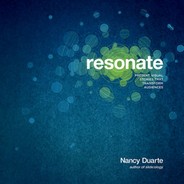126 Resonate
Now that you’ve created meaningful messages, how
do you arrange them for maximum impact? You struc-
ture them in a deliberate and logical way. A solid struc-
ture is the foundation of a coherent presentation, and
shows the relationship between the parts and whole.
It’s similar to the couplings on a train or the string of
a pearl necklace; it keeps everything connected in an
orderly fashion, as if the content were destined to fit
together neatly within a given framework. Without
structure, ideas are easily forgotten.
Establish Structure
There are several ways to do this. You can use sticky
notes, tape slides on a wall, or lay them on the floor. Any
method that pulls your content out of a linear presenta-
tion application will work. Moving out of a slide-creation
environment helps identify holes and keeps you focused
on the bigger picture. This will help move your presenta-
tion from being about a bunch of small parts to being
about a single big idea.
Clustering your content helps you visually assess how
much weight you’ve given to various portions and how
many supporting points you need to get your message
across. Use this technique to confirm that you’re empha-
sizing the correct content and allocating appropriate
time for each message.
Keep in mind that the structure should accommodate
the audience’s comprehension needs and should be
assembled in a way that’s palatable to them. It’s natural
for subject matter experts to prepare material linking
ideas that are closely connected in their own minds,
but remember that the audience might not see these
relationships as readily. Connect your messages in a
way that your audience can follow. The structure should
feel natural and make common sense to them!
This section will walk you through various structural
devices for organizing your presentation. Most presen-
tations that fail do so because of structural deficiencies.
When the structure works, the presentation works. If one
is sound, the other will be sound. A good structure helps
you work out the kinks and eliminate the extemporaneous.
“It’s unwise to merely dump a pile of unstructured
information into the laps of your audience. They will
have the same reaction as if you take a watch apart,
fling the pieces at them and say ‘Here’s all you need
to make a watch.’ You might get high marks for
research and energy, but that is a low-class consolation
prize. By doing this you confess that you don’t know
what to do with all the stuff you’ve dug up. Audiences
expect structure.”
Henry M. Boettinger
1
Most presentation applications are linear and encour-
age users to create slides in a sequential order. One
slide follows the other, which naturally compels the
user to focus on the individual details instead of the
overarching structure. To help your audience “see”
the structure, move out of the linear format of the
presentation application and create an environment
where you can look at the content spatially.
CH006.indd 126CH006.indd 126 8/16/10 5:01:28 PM8/16/10 5:01:28 PM

CH006.indd 127CH006.indd 127 8/16/10 5:01:29 PM8/16/10 5:01:29 PM
..................Content has been hidden....................
You can't read the all page of ebook, please click here login for view all page.
